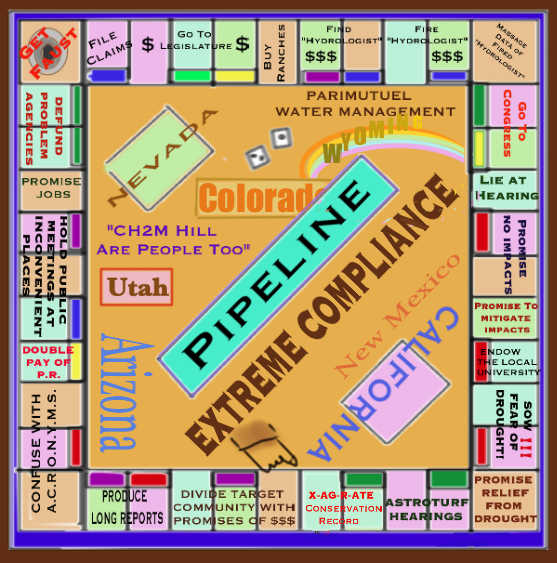High good, low bad: Mead in December 2012
Posted on | December 30, 2012 | 2 Comments
 WHAT western water managers preach and what western water managers do is often contradictory. This much can be relied on: inconsistency starts at the top. Only this month a long-awaited report issued by the federal Bureau of Reclamation emphasized the need for conservation over big infrastructure projects. And we can trust its conclusions in that pointlessly hyped McGuffin projects such as diverting the Mississippi to the dry West or towing Alaskan icebergs to San Diego will not happen any time soon. However, only weeks after the release of the Colorado River Basin Water Supply and Demand Study, during the dead time between Christmas and New Year, Reclamation’s parent agency, the US Department of Interior, green-lighted the driving of a massive pipeline from Las Vegas hundreds of miles north into the Great Basin. This is the opposite of conservation over big infrastructure and its approval comes in spite of clearly devastating implications for thousands of square miles across the Great Basin.
WHAT western water managers preach and what western water managers do is often contradictory. This much can be relied on: inconsistency starts at the top. Only this month a long-awaited report issued by the federal Bureau of Reclamation emphasized the need for conservation over big infrastructure projects. And we can trust its conclusions in that pointlessly hyped McGuffin projects such as diverting the Mississippi to the dry West or towing Alaskan icebergs to San Diego will not happen any time soon. However, only weeks after the release of the Colorado River Basin Water Supply and Demand Study, during the dead time between Christmas and New Year, Reclamation’s parent agency, the US Department of Interior, green-lighted the driving of a massive pipeline from Las Vegas hundreds of miles north into the Great Basin. This is the opposite of conservation over big infrastructure and its approval comes in spite of clearly devastating implications for thousands of square miles across the Great Basin.
Where, you might wonder, were our vaunted environmental regulations in all this? The short answer is that these laws and the agencies meant to enforce them are every bit as successful protecting our natural resources as the Securities and Exchange Commission is policing Wall Street. The Southern Nevada Water Authority deputy general manager who for many years fronted the Vegas pipeline once bragged to a local television reporter that she could get anything permitted. To judge by this week’s Record of Decision, she appears to be right. Watch enough projects go through environmental impact review and it’s hard not to conclude that this notionally protective scrutiny is nothing more than a line item on an infrastructure project budget. While reviews too rarely protect the environment, the expense turns out to be valuable to prospectors such as Las Vegas. Feigning diligence proves a useful inoculant against liability.
For a look at how big infrastructure projects and not a new era of conservation is dominating wider thinking in the West, it’s worth revisiting the under-remarked June 2012 Natural Resources Defense Council report “Pipe Dreams.” Then let’s close 2012 with a look at Lake Mead. According to Reclamation, on Christmas day 2012 the Colorado River’s largest storage reservoir was 52% full.
Tags: chance of rain > compliance > Lake Mead > Southern Nevada Water Authority
Comments
2 Responses to “High good, low bad: Mead in December 2012”
Leave a Reply



December 30th, 2012 @ 8:42 pm
Or is that 48% empty?
January 3rd, 2013 @ 7:08 pm
I know McGuffins, and now many links to read. Thanks.